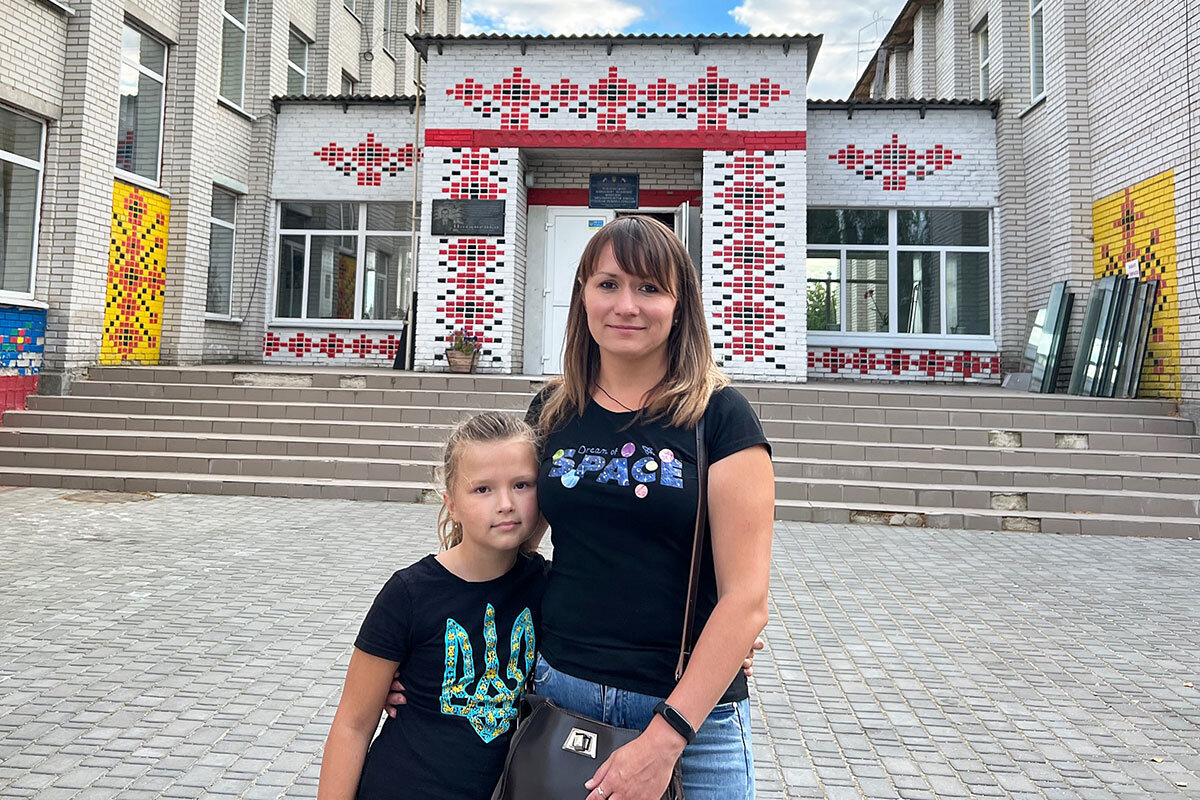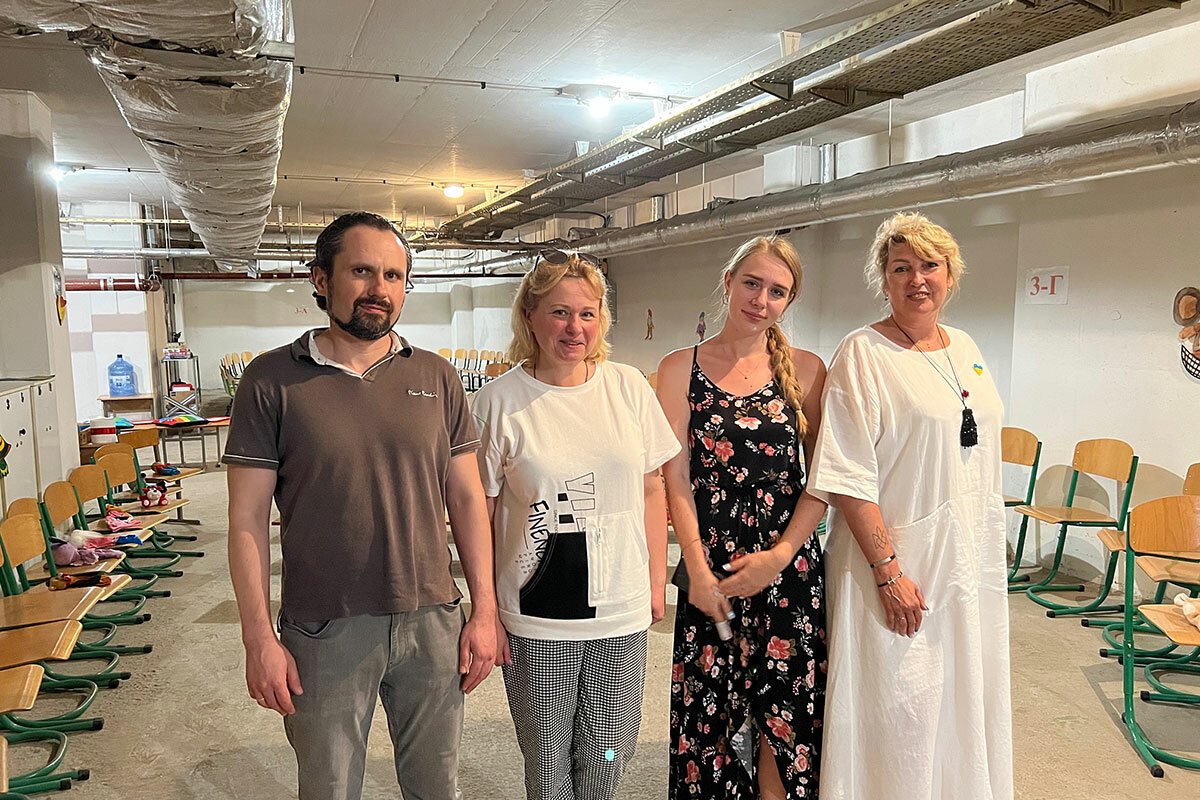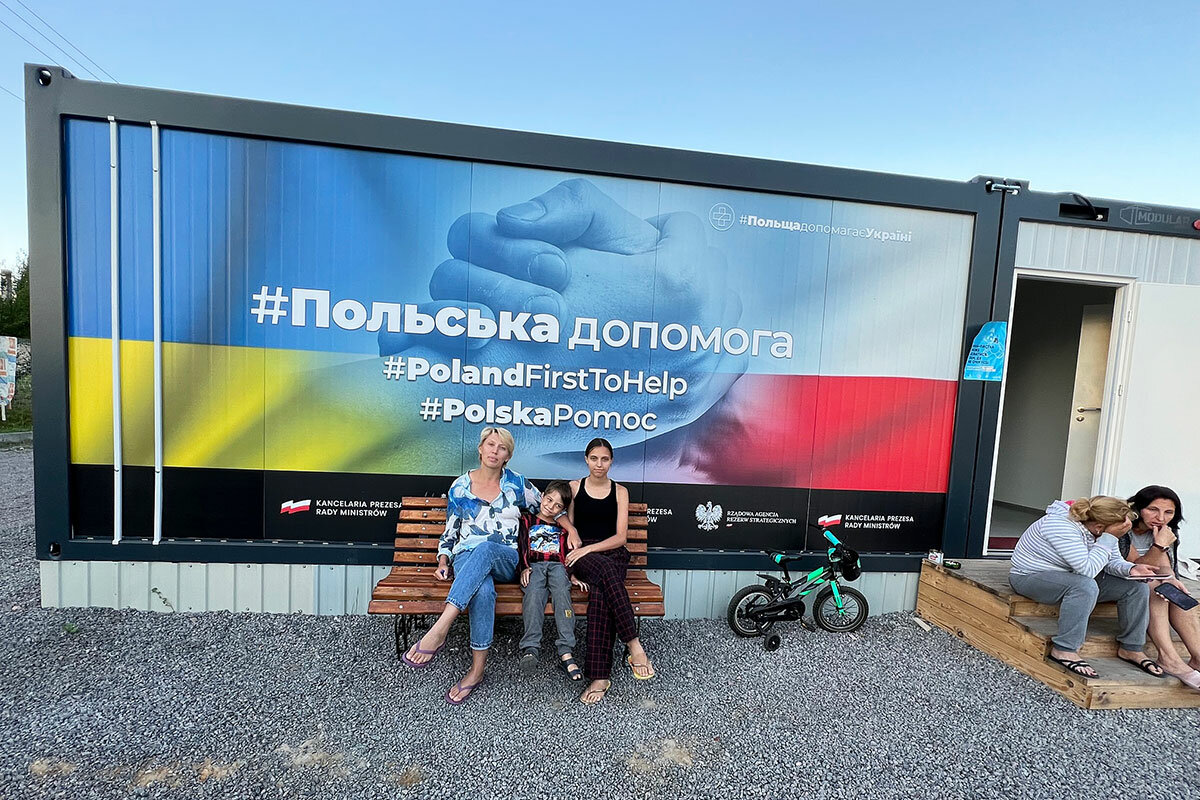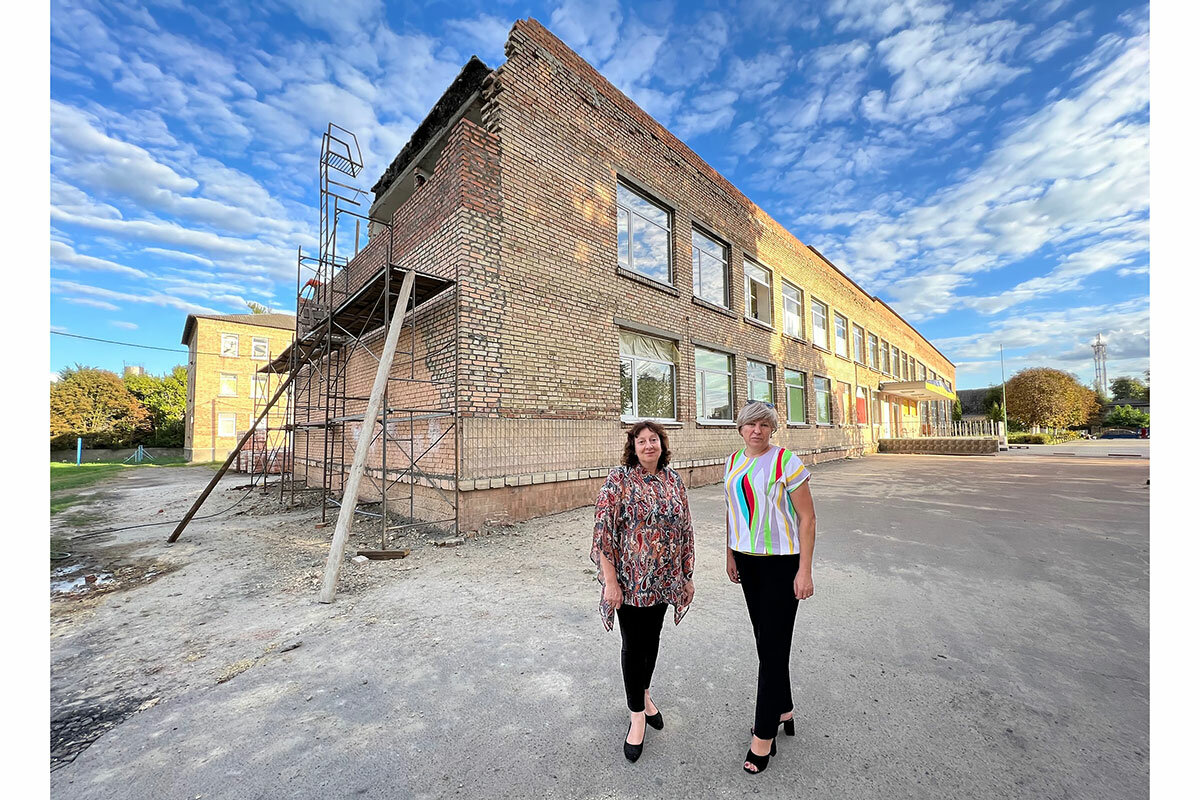Ukraine’s wartime schools: Intensity, purpose, and an eye to safety
Loading...
| MAKARIV, Ukraine
As a rising first grader, Masha Komarova was anxious to start school and make new friends in her new home in Makariv, a village about an hour west of Kyiv.
There was just one problem: Masha and her family had arrived in April from Kherson in southeastern Ukraine, a city now occupied by Russian forces. And in Kherson, Masha spoke Russian and was preparing for first grade subjects that would be taught in Russian.
But in Makariv – a town that suffered heavy Russian shelling for a month at the start of the war and was partially occupied but never fell to the aggressors – school instruction is strictly in Ukrainian.
Why We Wrote This
“School safety” is a buzzword everywhere, more so in a country at war. Yet as Ukraine launches a new school year, the war has also sharpened a seriousness of purpose – among educators and students alike.
“We’ve been working on the Ukrainian all summer, and she’s got it to where she’ll be fine with it,” says her mother, Anastasiia Komarova. While her mother speaks, Masha jumps around the steps to her new school, Makariv Lyceum No. 2, the Ukrainian national symbol on her T-shirt and an orange sucker in one hand.
“It’s been a little tough; there are words she doesn’t understand,” Ms. Komarova adds, “but she has the child’s ability to learn fast.”
As an estimated 4 million Ukrainian children started a new school year Thursday, there was much that was new about this opening day of school with the country at war.
In-school learning can only take place in buildings with bomb shelters, or with an accessible bomb shelter immediately adjacent. More time will be dedicated to safety education and to what school staff call “psychological first aid” – class discussions on dealing with the stresses the war brings, and allowance made for individual consultations with beefed-up school psychologist staffs.
A few instructional hubs have been set up to allow teachers displaced from the hottest conflict zones in the east and south to continue working remotely with their same students, including those still living in occupied areas.
The national course syllabus has been tweaked, as well: more Ukrainian history in history classes; and, in world literature, out with the likes of Tolstoy and Dostoevsky, in with Hemingway and Jack London.
“New motivation”
But perhaps most important of all, some of the country’s educators say, is a new sense of purpose for this school year.
“The message I’m getting from my students is that they really want to get back to school and get an education to use in the future,” says Marko, who asked that his last name not be used, a primary and secondary English and geography teacher in the Dnipropetrovsk oblast. The central Ukraine region is now home to thousands who have been displaced within the country.
The war has provided “a new motivation for students to study hard and find a profession where they can do something good to rehabilitate and renew the country,” he says. “They want to use all they’re learning in school to help people.”
In Kyiv Thursday morning, President Volodymyr Zelenskyy sounded a serious but similar note, addressing Ukraine’s schoolchildren on television from a sunny hilltop overlooking the city.
“This year’s Sept. 1 is very different from the 30 previous ones” in Ukraine’s history as an independent country, he said. The Russian invaders “stole part of your childhood, part of your youth,” the president said, “but you are free. You always will be. So be worthy of your freedom,” he added, “and of our Ukraine.”
At Ukraine’s Ministry of Education, officials say that while the war has brought many changes, the basics of the national endeavor to provide children with an education remain the same.
“Unfortunately we have had to add such things as ‘safety from mines’ to the topics of instruction,” says Andrii Vitrenko, Ukraine’s deputy minister of education. “But we are seeing that children want to study and learn; it is our task to make it possible to fulfill those dreams.”
The ministry says that less than a half-million of Ukraine’s prewar student population of 4.2 million have left the country, with some of those who have fled with their families to neighboring countries signed up to “attend” their Ukrainian schooling online.
Accommodations for all
Officials are confident that the three-tiered education system they developed for this year – some of Ukraine’s roughly 13,000 schools will be online only, some with only in-school instruction, and some a hybrid of the two – will accommodate all students from kindergarten to high school.
Clad in an olive-drab T-shirt he admits with a smile follows a “precedent” set by President Zelenskyy, Mr. Vitrenko says Russia’s invasion provided Ukrainians with another lesson about education.
“What we learned is that most of the Russian soldiers who came here with this war don’t even have a midlevel education,” he says. “That gives us even more reason to educate our children” to be better people.
In the capital, Kyiv, officials say the city has worked hard to make sure all children – both city residents and the thousands who have been displaced and have settled with their families here – are “in school” with either in-person or online classes.
But no priority has topped that of guaranteeing the security of children and school staffs this new school year with the country at war, Kyiv education officials say.
At a press conference this week in Kyiv‚Äôs first-through-11th-grade Millennium School, officials invited journalists to the school‚Äôs bomb shelter to underscore the city‚Äôs twin goals of accommodating as many students as possible in school buildings ‚Äì what they call ‚Äúoffline‚Äù education ‚Äì while keeping everyone safe. ¬Ý¬Ý
“We’ve put all of our resources into assuring the safety of our children,” says Valentin Mondriivskyi, deputy head of the Kyiv city administration. Noting at the same time that the city expects nearly 80% of this year’s estimated 178,000 student population to opt for in-school learning, he adds, “This tells us how important the offline system is for a good education” in the eyes of parents, students, and teachers.
Highlighting the underground space’s art tables for younger children and discussion circles for older students, Mr. Mondriivskyi says, “We want to make these shelters not a territory of fear, but a place of learning and development.”
A place for those displaced
Given its resources and isolation from the front lines, the Kyiv school district is one of the more unscathed by the war. But even here, numbers reveal a shrunken system that at the same time must adapt to accommodating a new student population – those internally displaced.
The city’s anticipated student population of 178,000 is down sharply from last year’s 300,000. But included this year will be about 3,800 students displaced from the war’s hotter conflict zones – although officials say they expect that number to rise as the school year progresses.
Mirroring the student population decline, the city’s total number of teachers and school staff members is also down considerably, from 77,000 last year to 57,000 this year – declines that hint at the millions who have left the country seeking refuge from the war.
But in many other parts of the country, particularly in the east and closer to the front lines, the new school year is much more precarious.
Some regions, or oblasts, have decided to offer classes online only – for the safety of students and staff, but also because many school buildings are still being used as shelters for those internally displaced – a population the United Nations’ International Organization for Migration estimates at 6.9 million and still growing.
In a recent study, the¬ÝInternational Organization for Migration found that at the beginning of July, nearly 1 million Ukrainians were living in 5,670 ‚Äúcollective sites‚Äù across the country, with schools, kindergartens, and student dormitories making up nearly three-quarters of those facilities.
And some schools are still being repaired after being damaged by Russian fire.
In Makariv, the town’s Lyceum No. 1 is being restored, brick by brick, from the artillery shelling it took in March.
“Of course the building can be rebuilt, but the children who were traumatized by having their school attacked in this way are going to need special attention,” says Natalya Kochkur, the school’s director.
Noting that two of the school’s students were killed in the shelling of Makariv, while two of the school’s graduates have died on the front lines, she says, “Our teachers are ready to educate our children and prepare their future.”
Of the fallen graduates, she adds, “We could say they died for this – for a peaceful and free Ukraine.”
Trade-offs
Yet not all of Makariv’s displaced families say they are finding the kind of “we’re in this together” spirit that officials talk about.
“I went to the school, but what I heard was a lot of bureaucracy and administrative things,” says Marie Zavrazhna, who arrived in Makariv with her two children this summer from the embattled region of Kharkiv. While daughter Varvara will follow her design courses online, son Ilya is entering the third grade in Makariv.
Yet even though Ms. Zavrazhna worries that overloaded school staff won‚Äôt have the time to receive Ilya ‚Äúin a good and friendly way,‚Äù she says it will still be better than the stress of keeping children where the war is a threat every day. ¬Ý¬Ý¬Ý¬Ý¬Ý¬Ý¬Ý¬Ý¬Ý¬Ý
Indeed, in some of the country’s occupied areas, Ukrainian education officials are in what some are calling a “hearts and minds” battle with Russian occupiers for those areas’ students and parents. Ukrainian officials are doing their best to make classes available online, while occupying Russian authorities are encouraging children to attend schools that will use a Russian instruction syllabus.
In the occupied city of Kherson, Russian officials are reportedly offering families new school uniforms, books, and other supplies if their children will attend school. Ukrainian forces this week launched an anticipated counteroffensive to free the city.
Kherson refugee Ms. Komarova says she’s heard about the Russians offering families 10,000 rubles to send their children to Russianized schools, but she doesn’t know of anyone taking the offer.
She’s been too focused on getting Masha settled in her new environment.
“Since the beginning of the war, it seems like life has been put on a bit of a pause,” she says. “I feel like if Masha goes to school, it will be something like normal again.”
Oleksandr Naselenko supported reporting for this story.








